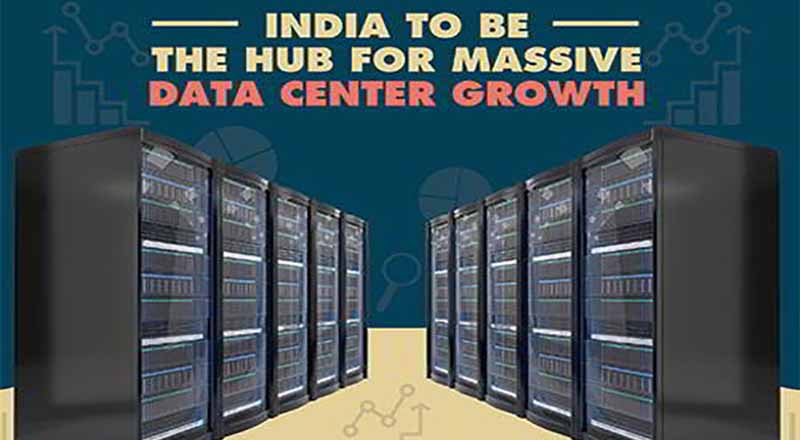Data localisation requirements in India has created a massive opportunity for the data centres to come up for meeting the local demand. More data means more data centres, which are growing at almost 25% CAGR. 5G rollouts and use cases for industrial IoT start gaining steam, demand will increase.
The cloud market is growing at 40% and a lot of investment is going towards supporting this and building next-gen infrastructure. The data centre market in India has doubled in the last 3 years and is projected to grow 1.5x by 2020. The overall cloud services market in India is expected to touch $4 billion by 2020.
To meet this growing need, existing and new providers are building new capacities across India. The reason of growth is government’s digitisation drive and thrust on Smart Cities is also fuelling demand for more data centres. Now the global datacentre giants are eyeing to enter India, which includes names like Equinix and Colt Data Centre Services.
Data center business is a very high capex business and therefore 99.9 percent developers in India will never be able to enter the space. The demand is massive and we are here to fill the demand-supply gap in the market. An expert says, It should be wise for the corporates and MNCs to aware on, they have to have their own data centres, so that all the data has to be inside the country, else it’ll be difficult for them to operate their business in India. Secondly, there will be few other regulations to come soon, hence they have to well prepared.
Prime Minister Narendra Modi who said he wants a digital India. He wants Make in India, he wants data to be located in India and a $5 trillion economy. If you put these together, the data centre space that has grown over 100 per cent year-on-year in the last two years, will grow at the same pace in the next five years.”
There are few datacentres in India including, Ctrls, ESDS, NTT Netmagic and Sify ,where they have multiple centres in multiple cities, but this will grow further to at least 20 times, what is existed in India. CtrlS Datacenters plans to invest Rs 626 crore to build two new data centres in Bengaluru and Chennai even as multinationals such as Microsoft and Amazon are investing on data centres in India. IBM has already started its first datacentre in Mumbai, Microsoft has announced a Rs 1,400 crore investment in setting up three data centres in the country
After Adani group announced plans to enter the data centre space with ₹70,000 crore investment plan, another Mumbai-based real estate developer Hiranandani launched a new data center business called Yotta. (The real estate group has roped in Netmagic’s former executive director Sunil Gupta as the CEO of the newly formed Yotta) . Hiranandani said, the company continues to build more datacentres for Netmagic while at the same time it will be building 11 datacentre buildings of its own in Panvel, Mumbai and Chennai. A 100 per cent subsidiary of the Hiranandani Group.
Getting on a triple digit growth in the data centre space in India, Hiranandani group is looking to invest about ₹15,000 crore over the next 5-7 years in setting up data centres in Mumbai, Panvel and Chennai.
NTT Com-Netmagic Solutions on its part will also expand its data center network in India. The data centre in Mumbai is already under construction and will be operational by June 2020. The company is looking at Chennai and Navi Mumbai for setting up two more data centres. The company so far has set up nine centres across Mumbai, Bengaluru, Chennai and Noida, and is growing at a CAGR of 30 percent. NTT, the parent company, has so far invested over Rs 2,700 crore for datacenters in India from 2014 to 2018, and there would be more investments coming in for its upcoming hyperscale datacenters.
CtrlS Datacenters is in the business of managing complete IT infrastructure & applications of enterprises, colocation, Disaster Recovery and Business Continuity Planning. The company is addressing all these demands by adding 5, 00,000 sq. feet of Tier 4 datacenter space across major cities in India. It is all set to pump in additional ₹2,000 crore to set up three new data centres. The new data centres in Mumbai, Hyderabad and Chennai would cater to the increasing data localisation demand from the government.
ESDS, which has two data centers in India (one in Mumbai and another one in Nashik)has a very strong Cloud platform that takes care of redundancy on the IT Infrastructure level. ESDS chose to invest in building a highly secure Network and isolation of IT Infrastructure to guarantee 100% secure cloud hosting environment for its customers, with all datacenters connected by 10 Gbps backbone network.
Alibaba, the global cloud giant has set up its first data centre in Mumbai, collaborating with existing Cloud Service Providers (CSP) in India to set up its second data centre in India.
In India, colocation setups are being deployed with cloud computing architecture, putting the country on a path to becoming one of the biggest hubs for colocation data centres globally. Colocation data centres are shared facilities where the infrastructure is used by different companies.
The country’s first data centre park will come up on a 600-acre of land next to Taloja industrial estate in Navi Mumbai, owned by the MIDC. “Mumbai has the first mover advantage [over Chennai] and an opportunity to establish itself as yet another global data centre capital, similar to Singapore or Virginia in the US,” P Anbalagan,CEO, MIDC said.
Oracle unveiled its Gen 2 Cloud first India data centre in Mumbai with another planned in Hyderabad. Oracle has signed up some of the large banks like HDFC Bank, Federal Bank, and Vysya Bank as clients for its India data centre. For now, the data centre will act as a direct competitor to AWS, Google, Microsoft and IBM. Oracle however is in the process of bringing its cloud application services also, making its applications accessible from anywhere.
ST Telemedia Global Data Centres (STT GDC), which currently has a capacity of 70 MW spread over 2.14 million square feet, plans to double this by March 2020, and grow further to 200 MW over 4 million sq ft, within three years.
Hewlett Packard Enterprise (HPE) has announced its plan to invest US$ 500 million in India over the next five years. This investment will enable the company to grow its operations, manufacturing and employee base in the country, increase its R&D and services exports, as well as invest in technology initiatives.India is one of the largest and fastest-growing economies in the world, and our investments will further develop the country as a critical market for HPE’s global business, as well as benefit our customers, partners, employees and the citizens of India,” said Antonio Neri, President and CEO of HPE .
Mumbai has several advantages including better connectivity with 10 submarine telecom cables landings as compared to the six to Chennai. As the number of internet subscribers in India is increasing rapidly because of a combination of factors including drop in cost of mobile broadband and proliferation of inexpensive smartphones. This data is currently carried through sub-sea cables and stored in data centers around the world. But India’s footprint in data centres is miniscule-less than 2% of the global capacity. Also, no core data centre has been installed in India due to a lack in quality infrastructure with reliable power though edge data centres, that are small-scale and located close to busine- ss units, are already operational here.
Anbalagan said, the first phase involves an investment of Rs 30,000 crore, half of which is FDI. The park will be built on 150 acres of land and the plot allotment is expected to start in January 2020. Phase-II of the park at Khalapur, where MIDC also owns land, will be even bigger, Anbalagan said. It will be on 500 of the total 2,000 acres of land. A recent Parliament bill makes it necessary to have data originating in India to be stored within the country.
An assessment paper study by MIDC stated: “Global trends in data localization and privacy are also being reflected in India through the new in-country data residency regulations wherein the Supreme Court declared privacy as a fundamental right and the Justice BN Srikrishna Committee released its first draft of the Personal Data Protection Bill on July 27, 2018. Once the Personal Data Protection Bill 2018 gets enacted, the entire data storage volume generated in India will reside within Indian shores and will also be processed and analysed within Indian precincts.”
Last year, the Reserve Bank of India mandated that all data of financial transactions should be located on servers in India. It also clarified that the data which is taken outside of India for processing should be brought back. This forced global companies such as Master and Visa card to begin the process of storing data in India.





